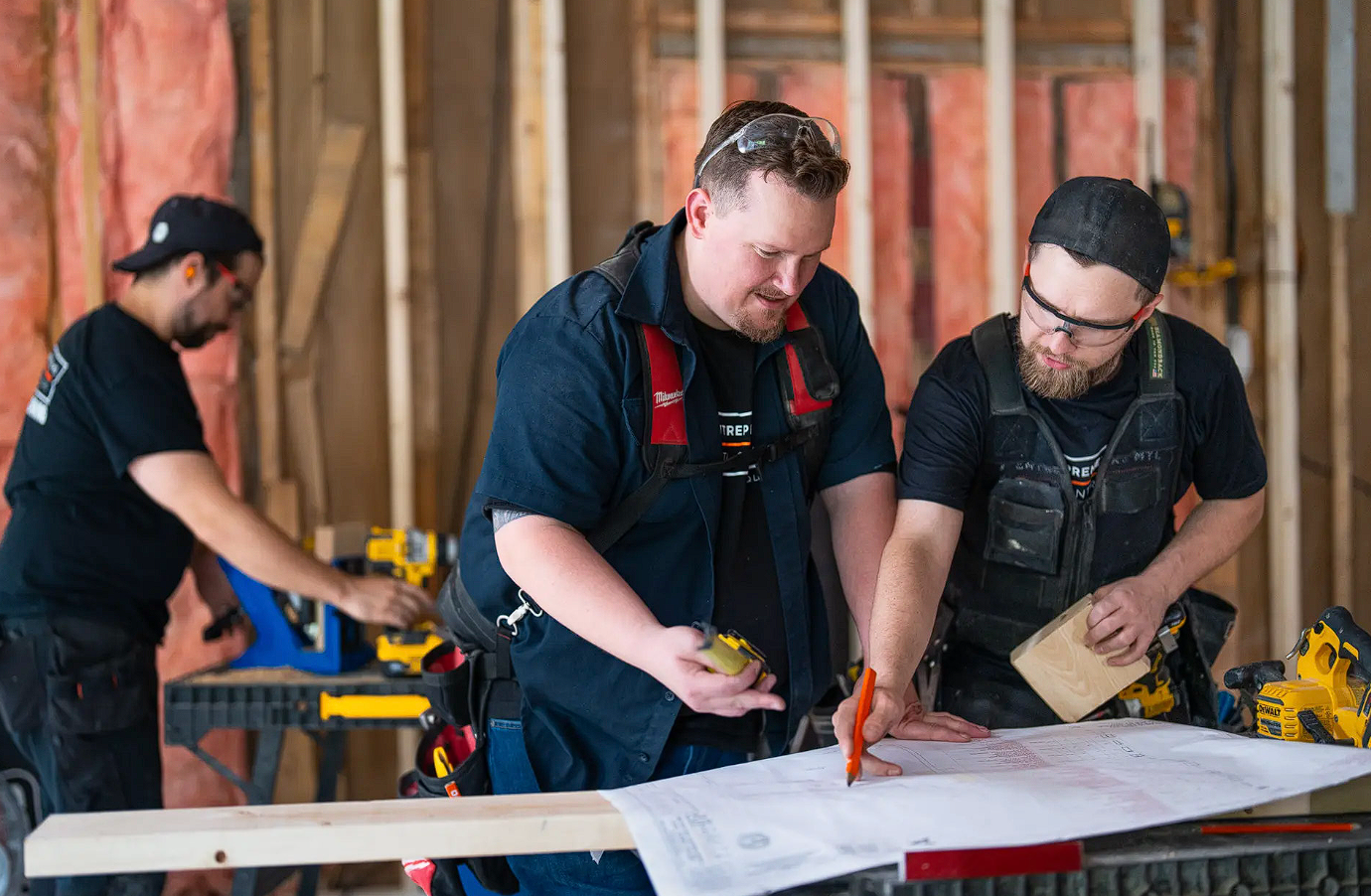How to Launch a Renovation Company in Quebec
By Editorial Team
Updated on August 7, 2025

Bringing to fruition an entrepreneurial endeavour doesn’t solely contribute to the province’s employment rate, it's an accomplishment that rewarding on both professional and personal levels. This is all the more true if you’re operating in the construction industry, an all-important sector in Quebec’s economy, encompassing numerous professionals and trade groups.
Considering that organization and information are the keys to entrepreneurial success, we’ve put together an article detailing, step-by-step, the guidelines to start a renovation company. We’ll elaborate on everything from feasibility, financing, conformity, and insurance, by way of online visibility and client acquisition. Happy reading!
7 Steps to Starting a Renovation Company in Quebec

Source : M.A. Structures inc.
1. Venture as an entrepreneur in the construction industry
The entrepreneurial life isn’t one of leisure; several aspects must be considered from the get-go. The idea of being one’s boss can be appealing, but appearances can also be deceiving. An entrepreneur rarely only works 40 hours a week, especially during those crucial first few years in business.
Without a doubt, running your own renovation company would be a valuable experience, but you do need to have a certain skill set to ensure your projects materialize in the end. Being a successful entrepreneur depends on your personality type; here are some must-have personality markers:
Leadership skills
Taste for risk coupled with a fearless attitude toward failure
Problem-solving abilities
Stellar work ethic
Diplomacy
Substantial self-assurance
Great communication skills
Easily find clients starting today
Get started today and connect with the projects that suit you best!
2. Determine the project’s feasibility

Source : MTL Contractors
All entrepreneurial ideas must start with a series of questions to determine the project’s feasibility. Whether you’re planning on starting a construction-based business, or something else for that matter, there are useful methods available to enlighten your path. There is, for one, the Entrepreneurial Potential Self-Assessment, made available by the Business Development Bank of Canada (BDC), allowing you to weigh your entrepreneurial traits. Also, if you happen to be between 16 and 35 years old, your local Carrefour Jeunesse Emploi (Youth Employment Services) can advise and help guide your entrepreneurial project’s progress.
One of the most important questions to ask yourself is that of funding. You should assess your personal finances, both in terms of needs (family and social life) and as far as resources go (assets, liabilities, income, debts).
Owning a company implies making sacrifices in certain aspects of your life. This is all the more true when it comes to actually launching your business, so it would be wise to ask yourself: Will I have to give up on my hobbies? Is my family ready to cut back? What are my goals in terms of return on investment?
Once these financial and personal questions are addressed, now comes the time to take the first step toward reality by carrying out extensive research regarding the renovation market in Quebec and nearer to your geolocation. Having an entrepreneurial idea is a start, but you have to ensure that it meets a constant need or a growing one.
It’s also worth establishing a business plan, which will be especially useful when taking your project proposal to a bank or potential investors to showcase your project’s viability. A business plan is a document detailing all quantitative, qualitative, and financial data related to your start-up.
3. Fund your renovation start-up
Acquiring funding is paramount to bringing your entrepreneurial project to life. A company lacking financing has fewer chances of seeing daylight. Funding can come from several different sources and is allocated in various forms (grants, loans, etc.). As a matter of fact, the business plan you’ll have put together must detail the exact amounts required to launch your business.
The required budget can come from:
Personal investment (often required to obtain a loan or grant)
Love money (family members or friends)
Bank loan
On top of that are several different types of financing, such as government funding. For more information regarding funding for your entrepreneurial project, click here.
4. Choose a business legal form

Source: RenoQuotes
Launching a renovation company involves choosing a legal form. You should do so prior to requesting a licence application. The Corporation des Entrepreneurs Spécialisés du Grand Montréal (CESGM) will be able to provide you with detailed information regarding options made available to you, amongst which sole proprietorship, joint-stock company, or general partnership are mentioned.
Bear in mind that the legal form retained will be a determining factor regarding the laws by which you must abide once your company is operational. Note that there are so many factors to consider when launching your company. First off, the CEO’s benefits plan (as an employee or independent contractor) will significantly impact their level of insurance.
Without question, if you’re doing business with investors, you have to choose the proper form of investment based on your future targets when it comes to your company. A banker, financial adviser, or accountant can guide you toward making a well-informed decision.
5. Adhere to legal obligations
A company’s operating activities mandate meeting various formalities based on one’s specific business situation. This is all the more true in Quebec, in a sector known to be highly regulated. Conforming with legal obligations regarding your activities within the construction industry will allow you to abide by current standards and regulations. When it comes to a renovation company, there are three steps to legally operate it:
Register Your Renovation Company
First and foremost, you’ll need to register your company with the Registraire des entreprises du Québec (REQ). The registration process is meant to group together information relating to companies and individuals operating in Quebec. Once you have registered, the registry will grant you a Quebec Enterprise Number (NEQ), which will help you identify your company with the registry, government organizations, and citizens.
Obtain a Renovation Contractor’s Licence
Don’t turn a blind eye to the fact that, in the province of Quebec, operating within the construction industry means obtaining a contractor’s licence. Depending on your area of specialty, the licence in question will be allocated by one of the following organizations:
Corporation des maîtres mécaniciens en tuyauterie du Québec (CMMTQ): Entities operating in heating and plumbing
Corporation des maîtres électriciens du Québec (CMEQ): Entities operating in electricity
Régie du bâtiment du Québec (RBQ): All other categories
To obtain your licence, certain organizations, such as the CESGM, offer test preparation training. Said training lasts 15 hours and includes administrative education, construction worksite safety management, and construction work management. There’s also another training course available, specially designed to enhance proficiency regarding the content of the Construction Code.
Register Your Company with the CCQ
As a company operating within the province of Quebec, in the construction industry, you will be mandated to register your company with the Commission de la construction du Québec (CCQ).
Don’t Overlook Insuring Your Company!
In the construction industry, you’re always one mistake away from an injury, hence the need to be wholly insured. Given that you’ll be affiliated with the RBQ, you’ll have a licence bond, which is a financial guarantee used to compensate a customer—up to $40,000 for general contractors; and $20,000 for specialized contractors.
However, this guarantee doesn’t include liability insurance covering damages and accidents to others that will be used if your customer or neighbours suffer damages related to work executed under your oversight.
6. The value of online marketing

Source: RenoQuotes
A renovation company doesn’t differ from any other company, and it requires careful attention in terms of its development. Nowadays, countless construction companies are using online platforms to better market themselves. And, justifiably so, given this day and age. All customers looking to find a renovation contractor will start their research online.
As such, companies that have a strong online presence (those popping out first when initiating a Google search) are more likely to gain new clients compared to others. You’ll notice that all those companies have one thing in common: they have a website.
With or without Internet savviness, it’s incredibly easy for any contractor to create a website. There’s a plethora of free or pay-to-use tools to build an online platform, such as Wix, which is beyond simple to use.
Once your website is functional, you’ll simply need to feed it pertinent information about your company, services offered, pictures of prior projects, as well as your contact information. Some people will even go the extra mile and be highly active on social media. So, how’s your company's Facebook page coming along?
Here are a few marketing strategies for your construction company.
7. Client acquisition

Source: RenoQuotes
Successfully launching a renovation company rests on finding clients, while standing out from the crowd.
It’s much more than just a job; managing a renovation company is possessing your fair share of personal and professional assets to instill a sense of trust in your clients. The goal here? For them to request your services again. For them to refer you to their friends and family. Excellent customer service is paramount to establishing a good business relationship with your clients.
RenoQuote.com is a platform dedicated to connecting homeowners with construction or renovation contractors. It’s easy to use: Sign up for free via our online platform and let us know what type of project suits your line of work (plumbing, roofing, insulation, etc.).
From here, you’ll start receiving projects submitted by homeowners. Pay solely to acquire client information for projects that you potentially want to undertake. Clients receive 3 to 4 quotes for work they’re looking to complete and ultimately choose their contractor. It’s a quick and effective solution to acquire a new client base!
Will you need an office space? A commercial lease isn’t the same thing as a residential one. It depends on the rules specific to it, so it’s worth consulting with a paralegal regarding the matter. A legal assistant will be able to ensure that you’re properly covered by your lease should you want to cut your lease short or transfer it to someone else. Another matter that can be discussed is the degree of responsibility implied by including a personal bond within the lease.
Establishing a service contract also merits its fair share of attention. Lack of accuracy regarding the services offered and applicable rates is likely to cause disputes with your clients and, subsequently, tarnish your professional reputation. Furthermore, a service contract must allow your company to stand out from other companies operating within the same realm, and outshine your competitors to prosper at a decent rate.
Are you considering hiring employees or consultants? It’s worth looking into the terms and conditions to abide by when drafting their employment contract. Said document should also feature a non-disclosure and a non-compete clause. Hiring employees also means taking on the responsibility of ensuring their safety. As such, educate yourself regarding health and safety standards in the workplace by which you must abide to fulfil your obligations.
Becoming an Entrepreneur | Leadership, diplomacy, and interpersonal skills - Work over 40hr/week - Make sacrifices - Be confident and power through - Find an office space with a commercial lease - Network to find labourers |
Project Feasibility | Assess your entrepreneurial potential - Compile a financial and personal workup - Establish a business plan - Conduct market research |
Fund Your Project | Government grants - Bank loans - Personal investments - Investors (companies or loved ones) |
Legal Form | Sole proprietorship - Joint-stock company - General partnership - Employee or independent contractor |
Legal Obligations | Register company with the REQ - Get an NEQ number - Take exams to obtain a contractor’s licence (RBQ - CMEQ - CMMTQ) - Register company with the CCQ - Insure company for liabilities - Draft legal contracts with a notary |
Client Acquisition | Online marketing (social media, website) Word of mouth - Hire intermediaries - Build a distinctive brand |
Want to learn more about it? Check out this article.
Find clients for your home renovation company
RenoQuotes.com can help you get home renovation contracts. We get requests from clients looking for trusted home renovation professionals just like you. Fill out the form on our homepage (it only takes a few minutes), and you will receive information on how to get new clients for your renovation company through our service.
Dial 1-844 828-1588 to speak with one of our customer service representatives.
Looking for something else?
Related articles
The latest industry news, interviews, technologies, and resources.

Editorial Team
•15 Aug 2025
The renovation industry has witnessed significant growth over the last few years, and that’s despite inflation! A lot of homeowners, particularly baby boomers, are to thank, preferring renovating over selling their homes and moving. Renovations allow people to improve their comfort and quality of life, adding value to their property in the process.

Editorial Team
•03 Jun 2024
If you’re looking for a career in the construction industry where teamwork is essential and perfectionism is—at long last—valued, consider becoming a resilient interior flooring layer. This little-known profession, although essential, is seeing a significant labour shortage as a result of a large number of workers retiring.

Editorial Team
•07 Nov 2023
A sheet metal roof might sound absurd to some, but this material is quite popular for those searching for a long-lasting and strong overhead cover. In recent years, sheet metal roofing has been recognized for its durability and longevity. Unlike asphalt, which has a lifespan of between 20 and 30 years, sheet metal can last up to 50 years. Therefore, installing this roofing material is a worthwhile, lifetime investment!

Editorial Team
•07 Nov 2023
Your home is an investment and an expensive and important one at that. Of course, signs of damage to any piece of your house would be concerning.

Léa Plourde-Archer
•07 Nov 2023
When we talk about decor or design on the blog, we usually focus on home decor. This allows our readers to find sources of inspiration to create the perfect layout for their home. But what about those who are looking for ideas for their business?